
Kumar Lab, UC Berkeley
@kumarlabucb
Followers
3K
Following
4K
Media
211
Statuses
1K
Lab of Prof. Sanjay Kumar, @QB3Berkeley Director. Dissecting, modeling, and controlling biology with materials & mechanics Also at https://t.co/Vev0PQ7CMl
Berkeley, CA
Joined March 2017
New paper in Advanced Materials! We develop a family of 3D viscoelastic HA matrices and use them to study effects of stress relaxation on GBM invasion. Led by @EmilyCarvalhoGQ in collaboration with Andreas Stahl and @ManishKAghi
advanced.onlinelibrary.wiley.com
Glioblastoma spheroids invade faster in stress-relaxing, high-molecular-weight (HMW) hyaluronic acid hydrogels than in more elastic-like, low-molecular-weight counterparts. The long HMW chains...
2
5
53
Experimental studies were led by Erika Ding, with Takashi Yokokura conducting very valuable SCFT modeling under Prof. Rui Wang's guidance. Erika and Takashi are incredibly talented and motivated ... if you see one or both in a future faculty search, give them a close look!
0
0
0
This may explain why M makes such important functional contributions in mouse genetic models, and why H is so thoroughly phosphorylated (another longstanding mystery) – though studies with M and H mutants reveal a much more complex picture. See the paper for details!
1
0
0
Conversely, H's charges are much more mixed, yielding a condensed structure. However, H does swell and approach the brush periphery when H is charged via multi-site phosphorylation at its KSP repeats – just as it is typically found in the axon.
1
0
0
Very briefly, we show that despite M's smaller size, it populates the outer reaches of the brush at physiol ionic strength bc of its relatively segregated charge distribution. As a result M behaves like a polyelectrolyte, with charge repulsion driving chain expansion.
1
0
0
Since AFM can only measure an aggregate brush height, the expts were also closely coupled to (and guided by) SCFT-based modeling to gain insight into internal brush structure.
1
0
0
We sought to gain insight into this longstanding paradox by preparing recomb L, M, and H, assembling them as mixed-subunit "brushes" on surfaces, and characterizing these brushes w AFM and related surface techniques.
1
0
0
Paradoxically, even though H is much longer than M and should thus presumably play a dominant role in NF network assembly, pioneering mouse genetics studies from the 2000s implicates M much more strongly in governing axonal caliber and radial growth. How can this be?
1
0
0
NFs are IFs composed of 3 subunits (light, med, heavy) that co-assemble into bottlebrush-like structures. The C terminal IDRs of M and H form the "bristles" of the brush and are presumed to mediate interactions between adjacent NFs.
1
0
0
For those who mostly know us for biomaterials and mechanobiology, this is part of a 20+y thread of work aimed at understanding how NFs assemble into 3D networks that contribute to and protect axonal caliber.
1
0
0
Excited to share our new paper in @PNASNews on mixed, reconstituted neurofilaments (NFs). This work was led by ChemE PhD student Erika Ding and done in collab w Prof. Rui Wang and ChemE PhD student Takashi Yokokura here at Berkeley https://t.co/68oQqiSqs7
1
0
6
Wait, how did @profmikeking manage to like this post 12 times
1
0
3
What a pleasure to visit the iconic @NotreDame to give this seminar! Exciting to hear about the push to build in Bioengineering & Life Sciences, including some brilliant recent faculty recruitments and new lab space. Many thanks to @DHPGroup and colleagues ☘️
Great to have Dr. Sanjay Kumar @kumarlabucb from @BerkeleyBioE @QB3 @Cal_Engineer for our @AeroMechND @NDBioeng seminar. Learning a lot about the elements of time and biomechanics in tumor and stem cell biology! https://t.co/GsOWPXsyc6
1
0
18
Now up and running at https://t.co/QdD5nKK7ED for those interested in following us over there!
0
0
2
Paper also includes AFM measurements of both normal and tumor-laden brain to help guide material design. Congrats to @EmilyCarvalhoGQ and other authors!
0
1
3
We show that VE matrices support a special leader-follower mode of invasion in which leader cells use hyaluronidases to pave paths, with followers then exploit. Invasive morphologies closely resemble those previousy seen by intravital imaging
1
0
3
Thoroughly enjoyed the event! Thanks to the organizers for the invitation. Great things in store for @BUmechanobio
Up next: Dr. Sanjay Kumar @kumarlabucb from @QB3Berkeley presenting “Tales from the fourth dimension: Incorporating the element of time into biomaterial paradigms.” #mechanobiology #annualsymposium @BUCollegeofENG @BU_Tweets
0
0
9
Up next: Dr. Sanjay Kumar @kumarlabucb from @QB3Berkeley presenting “Tales from the fourth dimension: Incorporating the element of time into biomaterial paradigms.” #mechanobiology #annualsymposium @BUCollegeofENG @BU_Tweets
0
2
4
We're back with our faculty focus interview series! First up: Leah Guthrie, a @BerkeleyBioE faculty member & @QB3 faculty affiliate. Read the interview to learn more about the Guthrie lab's research, what inspires the lab's work & advice for trainees. https://t.co/hLDaeGJn7I
0
1
2
Work done as part of our ongoing, exciting collab w @ManishKAghi. Congrats @junghwacha and team!
0
0
3




